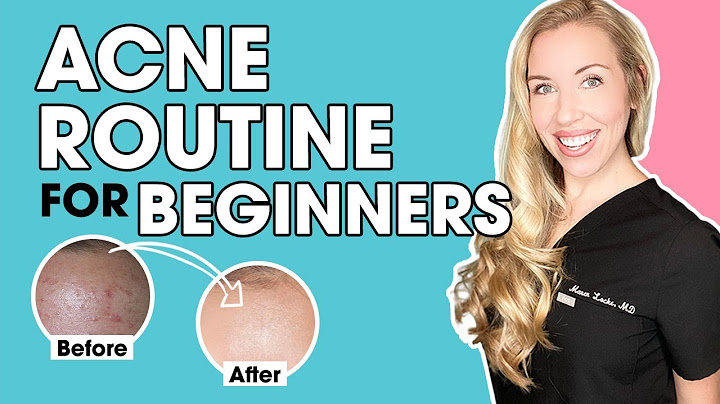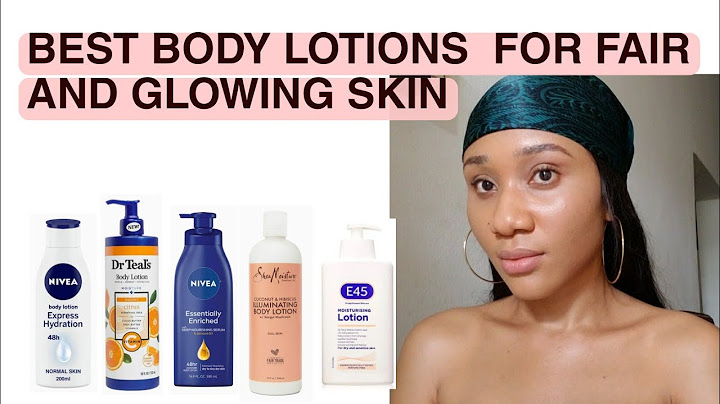Dry skin around the mouth and chin is a common skin issue that can cause redness and mild to extreme discomfort. While it is typically caused by lifestyle choices and environmental factors, dryness can also be caused by a poor skin care regimen. Show
Enhancing your skin care regimen is key to treating and preventing dry skin around the mouth. Skin hydration can be improved through regular application of creams and ointments, while SPF creams work to protect your skin from environmental damage. The exact treatment for your skin will depend on what is causing your dry skin to occur.
Dry skin around the mouth can be caused by a number of external factors, including the use of harsh skin care products or as a result of your environment. The skin’s outermost layer, known as the epidermis, acts as a barrier that protects the body and underlying layers of skin from damaging chemicals, pollutants and irritants. It also helps to maintain skin’s hydration and softness. Sebum is a yellow, oily substance produced by the skin’s sebaceous glands to bolster hydration. It is vital in keeping skin moisturized and protected; low sebum production can lead to dry skin around the mouth and chin. Fatty acids and cholesterol are also among the most important lipids for skin hydration. They improve the skin’s elasticity and help to heal a damaged skin barrier. While external damage to the skin’s barrier is often the cause of dehydrated skin, certain medical conditions can also be responsible, such as perioral dermatitis and angular cheilitis (AC) which can both lead to drier skin. DehydrationAt its core, dry skin is caused by a lack of moisture in the outermost layer of skin. This can simply be the result of general dehydration due to a lack of water consumption. Most adults should drink about 2 liters of water a day, however many consume far less than this recommended amount. The lips and mouth are among the first areas where the visible symptoms of chronic dehydration occur. Before altering your skin care regimen, first increase your water consumption levels and track your skin’s progress over several days to see if the issue resolves. Naturally dry skinOne of the most common causes of dry skin is a naturally low level of sebum production. Some experience lower than average levels of sebum production throughout their life due to genetics. Dry skin types require ongoing dry skin management as part of their regular skin care routine. Changes in hormone levels can sometimes briefly alter sebum production levels; for these cases, dry skin may only require temporary measures. LifestyleDry skin around the mouth and chin can be the result of poor habits and lifestyle choices including:
Skin care productsSome skin care products can compromise the outer layer of skin, hindering the epidermal barrier function and causing a significant loss of water that can lead to dehydrated scaly and flaky skin. For example, astringents and exfoliants are well-known for their drying effects and can have a detrimental effect on dry, flaky skin. Reduce the use of these products or avoid altogether to preserve moisture in the area around the mouth and chin. Skin care product preservativesCleansers, toners, lip balms, toothpastes and moisturizers often contain preservatives that can cause redness, sensitivity and extremely dry skin around the mouth. Some products can also trigger eczema and contact dermatitis. The following ingredients may irritate the skin and should be avoided:
Allergies and irritantsColorants and pigments can be found in a number of cosmetics and in most cases, they can be easily identified on a product’s label. There are two types of colorants: artificial and natural. Artificially-derived colorants, such as barium sulfate–which is used as a whitening agent–and aluminum powder, are particularly common and can provoke an allergic reaction. Artificial colorants can also increase the risk of irritation and may cause inflammation, dryness, or cracked skin around the lips. Medical conditionsPerioral dermatitis is an inflammatory skin condition found in both adults and children. This condition is characterized by a red, scaly or bumpy rash. Inflammation, redness around the mouth and mild itching or burning can also occur. Topical corticosteroid cream has been known to aggravate the condition and overuse of heavy face creams and moisturizers may also cause irritation, particularly on sensitive skin. Angular cheilitis is a bacterial infection of the lips that causes inflammation in one or both corners of the mouth. It can lead to redness, swelling and cracked skin. Contact dermatitis is caused by coming into contact with substances that provoke an allergic reaction. Lip balms, lipsticks, soaps, toothpaste and hair removal products can typically lead to a red, itchy rash near the lips. Dry Skin in the T-ZoneThe T-zone–the central area of the face that includes the forehead, mouth and chin–is often plagued by overly oily skin, or in some cases, particularly dry skin. This is especially true in the winter months due to harsh weather conditions and the drying effects of central heating that can damage the outer layer of skin. Taking basic precautions such as wearing a hat and scarf can help protect most of the T-zone from winter damage. Moisturizer and lip balm use should also be increased in winter months to compensate for the drying effects of indoor heating. While it may be tempting to forego sunscreen in the winter, the snow’s reflective surface can increase sun damage to the T-zone area; protect this area with an SPF sunscreen and lip balm. As the T-zone area is both particularly delicate and oil-prone, it is often the focus of skin care routines. As a result, the area can easily become overburdened by harsh skin care products causing dryness. When applying products to the area, it is important to read instructions and to use the products as directed. Watch for early signs of irritation, and discontinue use before serious dryness occurs. How to Treat Dry Skin Around the MouthDry skin around the mouth can often be treated effectively with the right hydrating products. When managing dry skin, avoid using products with a high oil content and strong scents as these may further irritate the skin. Moisturizers have multiple functions and while many formulas help to improve the appearance of skin and help it retain moisture, some can deteriorate the skin’s condition and weaken the outer layer. This is why it’s important to know which ingredients are in your skin care products. Cleansing routineCleansers are designed to clean the skin, remove makeup and general buildup accumulated throughout the day. However, many cleansers include surfactants: soaps that strip the skin and cause damage to essential skin proteins and lipids. As a result, skin can feel tight, dry and irritated. A mild and gentle cleanser is advised for dehydrated skin. Using a cleansers containing hydrating agents such as lipids, occlusives, and humectants will help retain the skin’s natural oils and reduce skin damage. Cleansing oils and balms are particularly beneficial for dry skin. Key ingredients to look out for include hyaluronic acid (HA) and ceramides. HA locks in moisture, helping skin appear plump, while ceramides are fats that help prevent further moisture loss. Gentle exfoliationGentle exfoliation can improve the skin’s texture and help buff away the natural buildup of dead cells. Exfoliate the area around the mouth and chin with a gentle formula using a slow circular motion. How often you exfoliate your face will depend on how sensitive your skin is. Start by exfoliating once per week and increase to a maximum of once every three days. If irritation occurs, decrease the frequency of exfoliation. You can also exfoliate your lips, if they are especially dry. When doing so, seek out the most gentle physical exfoliant available.It is important to keep lip exfoliation to a minimum, at most once per week. Facial hydrating serumFollow your cleanser with a facial hydrating serum that is silicone- and petroleum-free, and has a low oil content. Ingredients that promote hydration include glycerin and HA. Particular care should be taken with HA. While it can be an effective barrier to moisture loss when used properly, overuse can draw moisture out of the body leading to dry skin. Always use it sparingly and follow with a hydrating moisturizer and broad-spectrum SPF to protect your skin from damaging UV rays. Broad-spectrum SPFThe sun is known to have a drying effect on the skin, especially if the skin isn’t protected properly. It can deplete the skin’s supply of natural lubricating oils and worsen dry facial skin. Apply a broad-spectrum sunscreen daily following your face moisturizer. This will protect you against harmful UVA and UV rays which are known to accelerate the aging process and damage the skin barrier. Some lip balms also contain SPF, which will help protect and condition dry skin on the lips and around the mouth. Always use an SPF of 30 or higher for maximum protection and coverage. Effective Preventative MethodsFor individuals already consuming adequate amounts of water, the use of topical emollients will improve the skin’s barrier function and improve the look and feel of dry skin. Using skin care products with added emollients (moisturizers) will help lock in the skin’s natural oils for healthier looking skin. In addition to this, skin care products and cosmetics containing preservatives, fragrances and artificial colorants should be avoided, as they may trigger allergies. Generally, it’s best to avoid overexposure to the sun, excessive washing and products with irritants or harsh chemicals, as this can further aggravate the affected area. When to See a DoctorIt can sometimes be difficult to identify the root cause of dry skin. If you are unable to isolate the cause of your dry skin, seek out professional help. Similarly, if you believe that an underlying medical condition is causing your dry skin, a professional will be able to confirm your suspicion. If you are concerned that your condition may be linked to medically-prescribed topical creams or other prescription skin care product it is best to seek professional advice before discontinuing use. TakeawayWhen dry skin occurs around the mouth, try to identify the problem before treating the condition. It may be easier to prevent further damage than to treat an ongoing issue. The first step in treating dry skin is to change harmful lifestyle habits and see if those changes result in a noticeable improvement. Eliminate certain products from your skin care regimen, particularly those containing preservatives, fragrances and synthetic colorants. Change any cleansers or moisturizers containing surfactants to formulas that are more hydrating. If dryness continues, add a facial serum with ingredients such as HA to your skin care regimen to help retain your skin’s natural moisture. You can also use a gentle exfoliator to buff away the natural buildup of dead skin cells. To protect your skin against harmful UV rays and environmental factors, apply a lightweight broad-spectrum SPF following your moisturizer. Finally, ensure you are drinking plenty of water and liquids to stay hydrated throughout the day. If the problem persists, consult a doctor or dermatologist who may be able to identify the root cause. Sources
» Show all What causes flaky skin around mouth?Exposure to dry weather conditions, hot water, and certain chemicals can cause your skin to dry out. Dry skin can also result from underlying medical conditions. Dermatitis is the medical term for extremely dry skin. There are several different types of dermatitis.
What does dermatitis look like around the mouth?If you have a rash around your mouth, you may have perioral dermatitis. This rash often looks like small, red, acne-like breakouts in people with light-colored skin and skin-colored breakouts in people who have skin of color.
|

Related Posts
Advertising
LATEST NEWS
Advertising
Populer
Advertising
About

Copyright © 2024 kemunculan Inc.


















